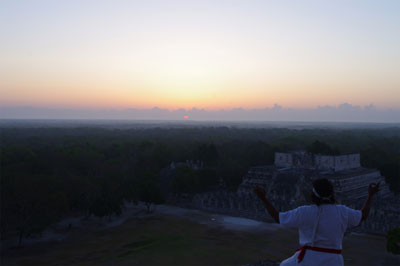The Science of 2012
Chances are you have heard or read that the Maya supposedly predicted the end of the world in the year 2012—December 21st, 2012 to be exact. This is simply not true. There is no evidence that the ancient Maya thought the world would end in 2012, nor are modern Maya people making such dire claims.

This artist's concept shows a celestial body about the size of our Moon slamming at great speed into a body the size of Mercury. NASA's Spitzer Space Telescope found evidence that a high-speed collision of this sort occurred a few thousand years ago around a young star, called HD 172555, still in the early stages of planet formation. The star is about 100 light-years from Earth. Some worry Earth will suffer a similar fate in 2012, but they shouldn’t. (Image credit: NASA/JPL-Caltech)
You may also have heard or read about a variety of doomsday scenarios for how the world will be destroyed: global warming, extreme weather events, earthquakes, volcanoes, a meteor impact, a magnetic pole shift, solar storms, Planet X, a gamma ray burst, or an ominous galactic alignment. Some of these events pose a real threat in any given year, while others pose very little threat, and still others are simply meaningless. Calendar in the Sky will address each of these topics in turn.
Additional articles on the Calendar in the Sky website will explain the Long Count calendar used by the ancient Maya. Misinterpretations of this calendar have lead to apocalyptic predictions for the year 2012. We will also examine some of the scenarios put forth by doomsday enthusiasts and uncover the real science behind them.
Over their long history, the Maya have used many calendars to mark time. Most modern Maya use the Gregorian calendar, along with a huge fraction of the world. Some modern Maya also use a ceremonial calendar of 260 days, called the Tzolk’in. The Maya of the Classic period, from about 300 BCE (Before Common Era) to 900 CE (Common Era), used another calendar to record events taking place over longer spans of time. We call this the Maya Long Count calendar. We don’t know what they called it, as its use in the Maya world ended with the collapse of the political structure at the end of the Classic period. By the time of the arrival of the Spanish in 1519 CE, knowledge of the Long Count among the Maya people had all but faded away.
The Long Count contained smaller cycles of time within larger cycles, very similar to the way the Gregorian calendar counts days within months, months within years, years within decades, decades within centuries, and centuries within millennia. The largest cycle in the Long Count was a period of 144,000 days called a Bak’tun. Based on the most accepted correlation of ancient Maya Long Count dates with the Gregorian calendar, December 21st, 2012 will mark the end of the thirteenth Bak’tun since the creation date of our age in ancient Maya mythology. 13 Bak’tun (equal to 5,125.366 years) was also the length of time of the mythological last age (previous creation) of humankind.
There is no evidence that the ancient Maya thought that our current age would last exactly the same amount of time as the previous, or believed that the Long Count calendar would end with the thirteenth Bak’tun. There is some evidence that they actually expected this age to last much longer than the last, and they recorded anniversary dates in the Long Count that would occur very far in the future.

Maya Priest Tiburcio Can May greeting the rising Sun on the day of zenith passage at Chichen Itza, Mexico. (Image credit: Bryan Mendez, UC Berkeley)
The end of 13 Bak’tun would certainly be a great time of celebration – like all the excitement for the year 2000 CE. However, we don’t really know what the ancient Maya thought about this date. There are no surviving records from that period that discuss it, save one stone monument inscription that is broken and difficult to interpret. All the ideas of this anniversary date being some great end or transition are modern inventions, most of them not made by Maya people at all.
Likewise, the doomsday scenarios of how the world could end in 2012 are also not coming from scientists, but rather authors or television/movie producers looking to profit off the paranoia of people. Many of the threats mentioned are real, but they have been faced by Earth every day since the planet formed some 4.5 billion years ago. It’s always wise to be prepared for natural disasters, as they can be difficult to predict precisely. But, the risks from most possible disasters have not changed much and show no signs of any increased risk in 2012, compared to any other year. Through all the disasters our planet has dealt with in its long history, Earth and the life clinging to its surface have always survived.
1345